Karva Chauth
Married Hindu women celebrate Karva Chauth, a one-day event, by fasting from dawn to moonrise and praying for their husbands’ health and longevity.
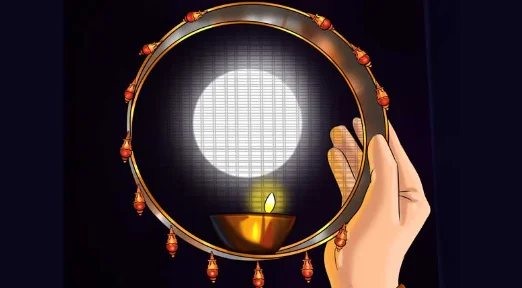 Unmarried women also participate, offering prayers in hopes of finding their ideal life mate. The festival takes place on the fourth day of the dark fortnight, known as Krishna Paksh or the declining phase of the moon.
Unmarried women also participate, offering prayers in hopes of finding their ideal life mate. The festival takes place on the fourth day of the dark fortnight, known as Krishna Paksh or the declining phase of the moon.
In the Hindu lunar calendar month of Kartik, which falls between mid-October and the end of October. Celebrations primarily occur in the northern Indian states of Punjab, Haryana, Himachal Pradesh, Uttar Pradesh, and Rajasthan.
Actual Meaning of Karva Chauth
The word Karva Chauth combines “Karva,” which denotes a clay pot with a spout, and “Chauth,” which indicates fourth. As part of the festival ceremonies, ladies use the clay pot to present water to the moon, making it extremely significant.
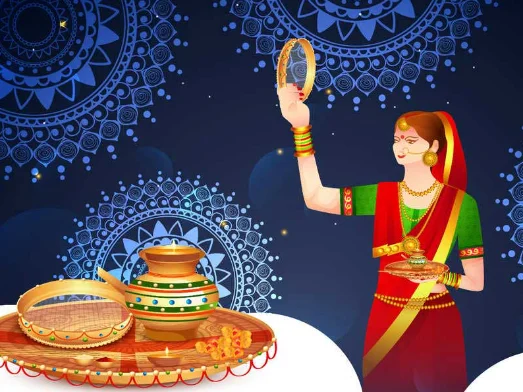 The event likely arose when wives began praying for their husbands’ safe return from distant conflicts. It is also said that people organize celebrations to commemorate the conclusion of the harvest season. Regardless of its origins, the celebration provides an opportunity to deepen family bonds.
The event likely arose when wives began praying for their husbands’ safe return from distant conflicts. It is also said that people organize celebrations to commemorate the conclusion of the harvest season. Regardless of its origins, the celebration provides an opportunity to deepen family bonds.
During the festival, ladies observe a “Nirjala” fast, abstaining from all food and liquids, and they pray to Goddess Gauri, an incarnation of Parvati, for blessings of a long and happy married life.
Mythology abounds with stories about Karva Chauth. One of the most well-known concerns Savitri and Satyavan, where Savitri used her resolve and prayer to save her husband from the grip of death.
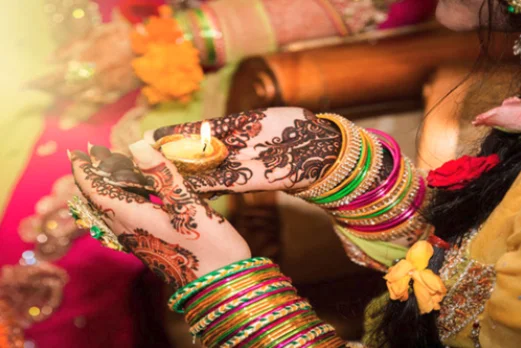 Another example is Veervati’s tale, about the lone sister of seven devoted brothers. The brothers, unable to bear seeing her fast for the entire day, tricked her into thinking the moon had risen.
Another example is Veervati’s tale, about the lone sister of seven devoted brothers. The brothers, unable to bear seeing her fast for the entire day, tricked her into thinking the moon had risen.
After breaking her fast and eating, Veervati soon learned of her husband’s passing. Appreciating her fervent devotion, the gods granted her husband’s life back after a year of prayer.
Punjabi Karva Chauth
Karva Chauth celebrations begin early in the morning, with married ladies getting dressed before the sun rises, much like in its neighboring states.
The woman’s mother delivers Bayaa, which includes presents for the mother-in-law and garments, coconut, candies, fruits, and sindoor (vermillion) for her daughter, the night before Karva Chauth.
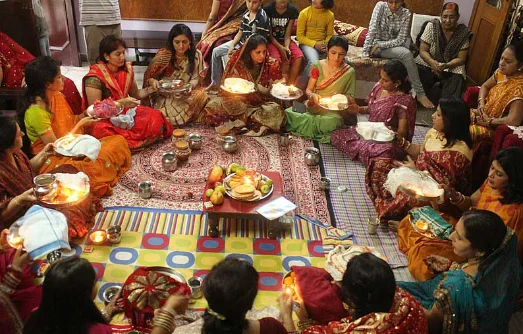 The daughter-in-law then eats the Sargi, which her mother-in-law gives her. Sargi, a meal eaten before daybreak on the day of Karva Chauth, consists of vegetables, chapatis, sweets, dried fruits, and fresh fruits.
The daughter-in-law then eats the Sargi, which her mother-in-law gives her. Sargi, a meal eaten before daybreak on the day of Karva Chauth, consists of vegetables, chapatis, sweets, dried fruits, and fresh fruits.
As the afternoon draws in, women gather with their own thalis (large plates). These thalis include presents for the mother-in-law, a coconut, fruits, dry fruits, a diya (lamp), and a glass of kachi lassi (a milk and water beverage), all covered with a fabric.
 Songs and Rituals
Songs and Rituals
The ladies then sit in a circle around the idol of Gaura Maa (Goddess Parvati), while an elderly wise woman tells the tale of Karva Chauth and ensures the pooja is done correctly. At that point, the ladies begin to revolve the thalis around the circle, a ritual known as thali batana. They perform this rite seven times, singing the following tune as they go along:
“Veeron Kudiye Karwada, Sarv Suhagan Karwada,
Ae Katti Na Ateri Naa, Kumbh Chrakhra Feri Naa,
Gwand Pair Payeen Naa, Sui Ch Dhaga Payeen Naa
Ruthda manayeen Naa, Suthra Jagayeen Naa,
Bhain Pyari Veeran, Chann Chade Te Pani Peena
Ve Veero Kuriye Kawara, Ve Sarv Suhagan Karwara”
The song emphasizes the safety measures that ladies who observe the fast must take. Following the pooja, ladies show their respect by touching their mothers-in-law’s feet and giving them presents of dry fruits.
When the moon shines brilliantly in the dark sky, it is time to break the fast. They bring a pooja thali that includes a diya (made of wheat flour), candies, a glass of water, and a chenna (sieve).
Process of completion of Karva Chauth
They often go to the terrace or another place where the moon is clearly visible. They present kachi lassi to the moon as they gaze at it through the sieve and pray the following for their spouses:
“Sir Dhadi, Paer Kadi, Ark Dendi, Sarv Suhagan, Chaubare Khadi…..”
The husband now serves his wife the same kachi lassi and sweets, and she massages his feet. They both accept their elders’ blessings, and that is how they break the fast.
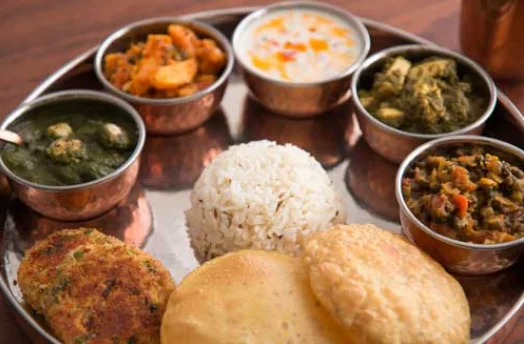 On the day of Karva Chauth, Punjabis eat rice, sweets from the Bayaa, pooris (fried Indian flatbreads), red beans, or green pulses like sabut dal.
On the day of Karva Chauth, Punjabis eat rice, sweets from the Bayaa, pooris (fried Indian flatbreads), red beans, or green pulses like sabut dal.
Bollywood films and television series have changed the customs surrounding this holiday over time. They have also contributed to the festival’s popularity in areas of India where it was not previously observed.
Nowadays, husbands also observe fasts for their wives, particularly among recently married couples. Consequently, people sustain the popularity of this ancient celebration by reimagining it in both rural and urban social contexts.
Karva Chauth process in Uttar Pradesh
The religious rituals start just before sundown, when local women gather to pray in traditional garb, colorful clothing, and garlanded with flowers and traditional jewelry.
ALSO READ: Rath Yatra | भगवान जगन्नाथ की रथ यात्रा का महत्व
Following this, ladies make prayers to Goddess Paravati, exchange thalis in a circle, and sing songs about Karva Chauth. In certain other regions, the mother-in-law and daughters-in-law exchange karvas and offer prayers at home.
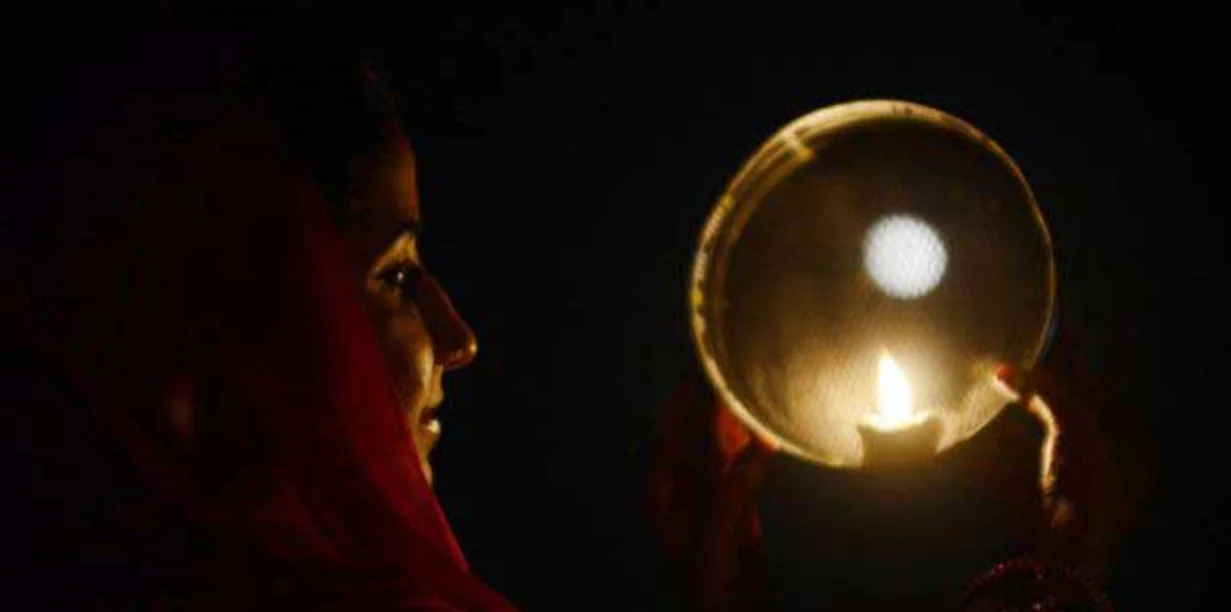 Then the elder ladies give the younger ones blessings, saying things like “sada suhagan raho” or “Akhand Saubhagyavati bhav,” which translate to mean “may you be a married woman all your life.”
Then the elder ladies give the younger ones blessings, saying things like “sada suhagan raho” or “Akhand Saubhagyavati bhav,” which translate to mean “may you be a married woman all your life.”
Last step
There is a nervous wait for the moonrise following the prayers. Women complete the rites by making prayers to the moon as soon as it appears.
In certain parts of Uttar Pradesh, people donate rice, flowers, sweets, and kumkum—a crimson pigment used by Hindus—while praying and drawing the face of the moon on the ground with rice paste. They then sing prayers and offer water through their karvas seven times. These chants include the following prayers:
‘Uth suhagan uth kulwanti nar, Bare Chanda ghee ke diye na baar’
Married ladies are urged to rise and offer prayers to the moon, since it is a more powerful lamp than all the earthly candles they illuminate.
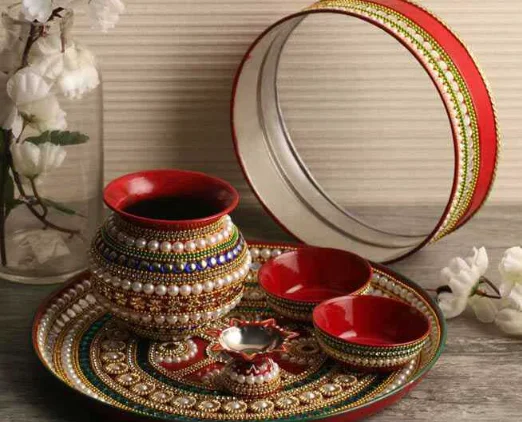 Songs and Rituals
Songs and Rituals

